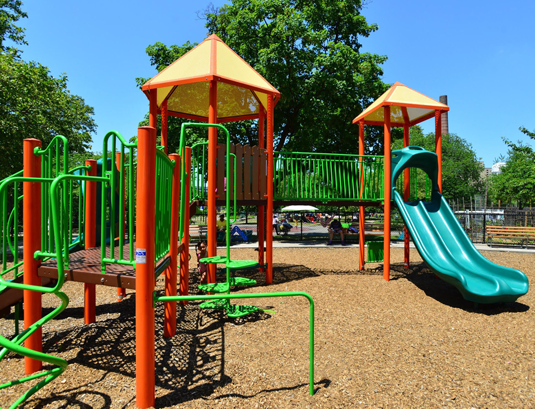Selecting Equipment for Your Outdoor Play Space

“Use your inside voices. No running, please. Follow the line leader. Sit in a circle…”
These are important things for children to do to maintain order in the classroom. Yet they’re not the default setting for healthy, active young people! Running, climbing, jumping, unrestrained talk and laughter, and opportunities to explore at will are hardwired into every child.
That’s why providing a safe outdoor space that encourages vigorous physical play is a big part of developmentally appropriate play. Plan your playground so it includes opportunities for kids to build strength and coordination and test their large motor skills and abilities. Provide ways for them to stimulate their imagination, engage in fantasy play, and learn about the world they live in.
Whether you’re updating existing outdoor playground equipment or building a space from scratch, it’s bound to be a major investment. You will need to be aware of regulatory standards, licensing requirements, and building codes that govern playground design in your area, and speak with the fire marshal and other relevant professionals to ensure that your playground meets all the required standards. We strongly suggest that you become familiar with the guidelines included in the US Consumer Product Safety Commission’s Handbook for Public Safety and the guidelines developed by the Americans with Disabilities Act to be sure your outdoor play space offers safe, appropriate opportunities for all children to enjoy.
If this sounds overwhelming, don’t worry. We’re here to help with the regulations and guidelines. For now, just think about the types of equipment you’d like to see in your new outdoor play area:
1. Natural Playscapes
Consider creating a natural playscape instead of one that emphasizes manufactured equipment. Popular versions of these playscapes take advantage of natural topography, including small hills, mounds of dirt, trees, gardens, grass, and sand. You can even replace manufactured fencing with shrubs to create a more natural barrier. Typically, natural playscapes are not only less expensive but more interesting, as they evolve in change with the seasons. Ask a professional about drainage, the best trees to plant, and how to introduce natural elements such as logs, boulders, or shrubs. (Keep in mind that a combination of manufactured and natural is a good approach, and that keeping your playscape 100% natural does require a significant commitment to ongoing maintenance.)
2. Climbing Structures
Kids love to climb! Just make sure your choices are developmentally appropriate for the children who will be using them. For traffic control, make sure every climbing structure has two ways up and down. Since a child’s ability to climb up develops before they can safely climb down, one of those ways down should offer steps with a handrail. Vary platform heights on climbing equipment based on developmental milestones: 24 inches for infants and toddlers and 36-48 inches for preschoolers. Include protective enclosures in case of falls.
3. Add a Slide – or Two!
Freestanding or part of a larger climbing structure, slides are always a favorite. Incorporate platform at the top and surround them with safety services. Avoid metal, which can overheat and burn on sunny days.
4. Swings are a Favorite
However, given the potential safety risks, the amount of space they use, and the close supervision they require, many centers are choosing not to use them. To ensure a safe plan and proper installation, we strongly suggest consulting a professional, but here’s a few things to keep in mind:
● Limit the number of swings to two or three.
● Space them at least 1.5 feet apart and at least 9 feet away from any other equipment.
● Infant swings should have bucket-style seats.
● Toddler swings need a back support and safety belt.
● Swings for preschoolers and other children should be made of canvas or soft rubber.
5. Riding Toys
Invest in some high-quality steel riding toys with wooden seats, four wheels, and simple steering mechanisms. Look for vehicles with solid rubber tires and wheels without spokes or fenders. Check to see if replacement parts are available to prolong your investment. Be sure to include adaptive accessories to make riding toys accessible to children with disabilities.
6. Bouncing and Balance
If you have the staffing to supervise properly, small trampolines are very popular with children. You can purchase a balance beam through a catalog or built one onsite using landscape timbers or natural materials.
Overall, always consider the play value in the equipment you choose. Look for equipment that stimulates more than one type of play. Assess whether the structure will grow with your children by offering more than one level of challenge.




